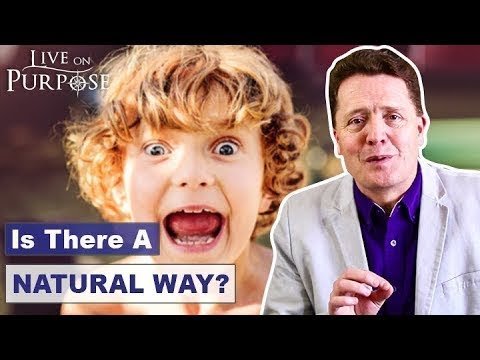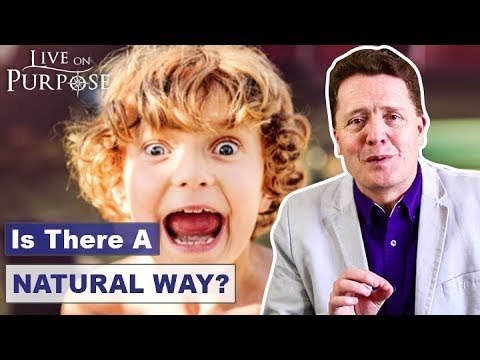The video “Natural Remedies for ADHD in Children” is a must-watch for anyone seeking alternative solutions to medication for their child’s ADHD. The speaker, from Live On Purpose TV, outlines a 4-part process that can help children with ADHD improve their focus and concentration. The process involves giving children tasks they can handle, allowing them to make mistakes and learn from them, and using consequences and empathy as teaching tools. The video provides examples of how this process can be implemented, including a teenage girl who is given tasks to handle, makes mistakes, and learns from them. By following this process, parents can help their children develop better decision-making skills and manage their ADHD symptoms naturally.
In this engaging video, the speaker from Live On Purpose TV shares proven natural remedies for ADHD in children. Acknowledging that medication is the preferred treatment for ADHD, the speaker introduces a 4-part process that can be used alongside or instead of medication. This process includes giving children tasks they can handle, allowing them to make mistakes and learn from them, and using consequences and empathy to teach them. Through real-life examples, such as a teenage girl who learns from her experiences, the video explains how this process can help children improve their focus and concentration. So if you’re looking for effective alternatives to medication for your child with ADHD, give this informative video a watch.

Giving Children Tasks They Can Handle
When it comes to helping children with ADHD, the first step is to give them tasks they can handle. This is important because it helps them build confidence and a sense of accomplishment. It’s crucial to keep in mind that children with ADHD may struggle with focusing and completing tasks, so it’s essential to set realistic expectations.
One way to determine if a task is suitable for your child is by considering their past experiences. If they have successfully completed the task before, it is a good indication that they can handle it again. Trusting their opinion about their abilities is also important. They may express doubt or resistance, but it’s essential to discern between lack of motivation and true inability.
To assess motivation, a helpful technique is the “5k test.” Imagine offering your child a substantial reward, such as $5,000, for completing the task. If you believe they would be motivated enough to do it, then it is a task they can handle. However, if the task is outside their ability, even with motivation, it’s crucial to adjust accordingly.
Letting Children Make Mistakes and Learn from Them
While it may go against our parental instincts, letting children make mistakes is an essential part of their learning and development process. When it comes to children with ADHD, mistakes can be valuable opportunities for growth. By allowing them to experience the consequences of their actions, we give them a chance to learn from those mistakes.
The cost of their mistakes increases as they grow older, so it’s important to let them experience the consequences at an early age. This helps them understand the cause and effect relationship between their choices and the outcomes. By providing empathy and understanding while allowing the consequences, we create a supportive environment for their growth.
By refraining from reminding and nagging them about their tasks, we change the dynamics and psychology of the situation. Smiling, instead of stressing and micromanaging, invites our children to think and make decisions on their own. Remember, our goal is to help them develop their executive functioning skills, even without medication.
Allowing Consequences and Empathy to Teach Children
Consequences and empathy play vital roles in teaching children with ADHD. Consequences are the natural results of their actions, helping them understand the impact of their choices. Empathy, on the other hand, involves understanding and caring about how they feel. Both elements are necessary for effective teaching and growth.
We should avoid the temptation to rescue our children from the consequences of their mistakes. By doing so, we rob them of valuable learning opportunities. It’s important to resist the urges to rant, rave, and rescue, as this sends the wrong message. Instead, we should allow the consequences to provide the necessary learning experiences.
Empathy is another crucial factor in teaching children. By understanding their feelings and demonstrating care, we create a supportive environment for growth. It’s important to avoid blaming or belittling them for their mistakes. Instead, we should focus on helping them understand the impact of their actions and encouraging them to make better decisions in the future.
Examples of Consequences and the Importance of Empathy
Examples of consequences for children with ADHD can vary depending on the situation. For instance, if a child forgets to do their homework, the consequence may be receiving a lower grade or having to complete extra assignments. If a child consistently leaves their room messy, a consequence could be losing privileges, such as screen time.
Empathy comes into play when discussing these consequences with our children. Instead of scolding or lecturing, empathizing with their feelings can be more productive. Showing understanding and care can help them develop a sense of self-awareness and responsibility. It’s important to express empathy while still holding them accountable for their actions.
By providing appropriate consequences and empathy, we can guide our children towards making better decisions. It’s crucial to remember that our role as parents is to love and support them through their learning process. By allowing them to experience the natural consequences of their actions, we equip them with valuable life skills for the future.
The Goal: Helping Children Make Better Decisions
The ultimate goal of implementing these strategies is to help children with ADHD make better decisions. By giving them tasks they can handle, allowing them to make mistakes, and experiencing the consequences, we equip them with valuable skills and knowledge. The focus is on fostering their executive functioning abilities and promoting personal growth.
These strategies not only help children with ADHD but can have broader benefits in their lives. By learning from their mistakes and making better decisions, they can navigate challenges with greater ease and resilience. It’s important to remember that this process is not about perfection but about continuous growth and improvement.
The Love and Logic Program as a Source of Ideas
The ideas and techniques mentioned in this article are based on the Love and Logic program. The Love and Logic program, developed by Foster Klein and Jim Fay, provides parents with effective strategies for raising responsible and resilient children. It emphasizes the importance of empathy, consequences, and allowing children to learn from their mistakes.
The Love and Logic program offers various resources for parents seeking guidance in dealing with challenging behaviors and teaching their children valuable life skills. It focuses on fostering healthy relationships and teaching children to take responsibility for their actions. Utilizing the principles of Love and Logic can help parents create a positive and nurturing environment for their children.
Teenage Girl Given a Task to Handle
To illustrate the application of these strategies, let’s consider the example of a teenage girl with ADHD. Her mother assigns her the task of attending all her classes consistently. Initially, the girl may struggle to meet this expectation due to her difficulties with focus and time management.
Mother Allowing the Girl to Make Mistakes
Instead of constantly reminding the teenage girl to attend her classes, her mother decides to let her make mistakes and experience the consequences. This approach may initially seem counterintuitive, but it aligns with the goal of helping the girl develop her executive functioning skills.
By stepping back and allowing her daughter to navigate the challenges on her own, the mother creates an opportunity for growth. This decision requires trust and faith in her daughter’s abilities to learn from her experiences. The mother understands that mistakes are valuable learning opportunities and that her daughter will benefit from facing the consequences of her actions.
Girl’s Inconsistent Attendance and Mistakes
As expected, the teenage girl struggles with attending all her classes consistently. She may face consequences such as missed assignments, poor grades, or having to catch up on missed material. These experiences provide valuable lessons on the importance of attendance and the impact it has on her academic performance.
Throughout this process, the mother demonstrates empathy towards her daughter’s challenges. She acknowledges the difficulties her daughter faces due to her ADHD and offers support and understanding. However, she does not bail her out or rescue her from the consequences of her actions. This balanced approach helps the girl develop a sense of accountability and self-awareness.
Using the Process as a Natural Remedy for Focus and Concentration Struggles
The process discussed in this article can serve as a natural remedy for struggles with focus and concentration in children with ADHD. By allowing children to handle tasks within their abilities, make mistakes, and experience consequences, we engage their executive functioning skills and encourage growth.
This process invites the brain to handle tasks differently, promoting self-monitoring and decision-making abilities. By allowing natural consequences to occur, children with ADHD learn the cause and effect relationship between their choices and outcomes. Through empathy and understanding, we create a supportive environment that fosters personal growth.
It’s important to note that while this process can be beneficial, it is not a substitute for professional guidance or medical treatment. Every child is unique, and it’s essential to consult with healthcare professionals and educators to create a comprehensive support plan.
In conclusion, helping children with ADHD involves giving them tasks they can handle, allowing them to make mistakes, and learning from the consequences. These strategies, based on the Love and Logic program, promote personal growth and decision-making skills. By implementing this process, we can support our children in their journey towards making better choices and developing their full potential.

